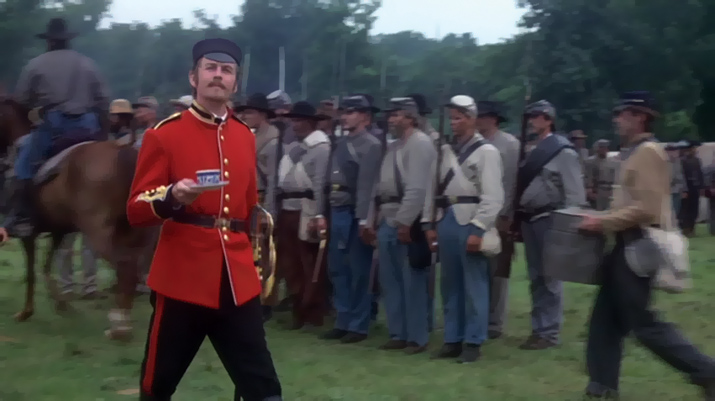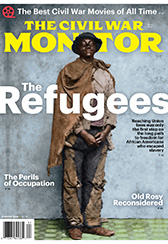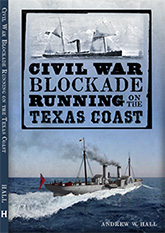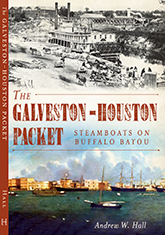Fisking Fremantle
Recently I uploaded a post in which I characterized Dr. Steiner’s famous account of Confederate troops entering Frederick, Maryland in 1862 as being unreliable, because (among other things) it was uncorroborated by other witnesses to the same event. The credibility of Steiner’s account is important, as it’s one of the references often cited as evidence of large formations of black soldiers serving in the Confederate Army. Steiner estimates their number as “over 3,000 Negroes” — an enormous number, something approaching the size of a full-strength brigade.
One of my commenters took me to task, saying that Steiner’s account is corroborated by the Fremantle Diary, an account of a British 0fficer’s travels across the Confederacy in the spring and early summer of 1863, and culminating with his witnessing the Battle of Gettysburg. I pointed out that Fremantle didn’t witness the Confederates’ entry into Frederick the previous fall, but my commenter assured me, “it’s the same army.”
This struck me as odd. Fremantle and I are old friends, as it were, since I first read his account years back while working on an archaeology project. I thought I was familiar with Fremantle’s account, but I sure couldn’t recall any references to Black Confederates in it. Furthermore, any reference to Black Confederates in “the same army” would be restricted to a relatively small part of the book, that covered Fremantle’s time with the Army of Northern Virginia — Chapters 10 through 13. I skimmed those chapters, and then the entire text, and came up empty.
So I did some Googling and came up with two brief passages that are cited over and over again on Black Confederate sites, such as this one. Fremantle’s texts are rarely quoted in full, but are most often summarized, which is the crux of the problem. More about that in a moment.
The first passage in Fremantle comes in a description of McLaws’ Division, marching north toward Pennsylvania, on June 25, 1863:
The weather was cool and showery, and all went swimmingly for the first fourteen miles, when we caught up M’Laws’s division, which belongs to Longstreet’s corps. As my horse about this time began to show signs of fatigue, and as Lawley’s pickaxed most alarmingly, we turned them in to some clover to graze, whilst we watched two brigades pass along the road. They were commanded, I think, by Semmes and Barksdale, and were composed of Georgians, Mississippians, and South Carolinians. They marched very well, and there was no attempt at straggling; quite a different state of things from Johnston’s men in Mississippi. All were well shod and efficiently clothed.
In the rear of each regiment were from twenty to thirty Negro slaves, and a certain number of unarmed men carrying stretchers and wearing in their hats the red badges of the’ ambulance corps; this is an excellent institution, for it prevents unwounded men falling out on pretense of taking wounded to the rear. The knapsacks of the men still bear the names of the Massachusetts, Vermont, New Jersey, or other regiments to which they originally be tonged. There were about twenty wagons to each brigade, most of which were marked U. S., and each of these brigades was about 2,800 strong. There are four brigades in M’Laws’s division. All the men seem in the highest spirits, and were cheering and yelling most vociferously·
Fremantle explicitly identifies the African American men as slaves. He makes no mention of arms or weapons, but does describe them as being “in the rear” of each regiment — i.e., not actually part of the formation of companies, along with the stretcher-bearers. There’s no suggestion that Fremantle viewed these men as soldiers. Nonetheless, some authors have written secondary accounts describing Fremantle’s observations, with some careful rephrasing that changes the the meaning entirely. An example of this is a post by James Durney over at the TOCWOC Blog:
[Fremantle] states that every regiment and battery has from 20 to 40 [sic.] black men traveling with it. His description of their dress and arms is similar to the description of Jackson’s command in 1862. This indicates that Lee’s army had not changed any policies and still contained a substantial number of black men. Longstreet had 72 regiments and batteries with just under 21,000 men carried on the rolls. If we use 20 black men with each battery and 30 with each regiment Longstreet’s Corps in July 1863 had just under 2,000 black men embedded in the units, an additional 9.4% above the official muster rolls.
Fremantle does not, in fact, make a blanket statement that “every regiment and battery” has a similar number of men traveling with it; he only describes the regiments he saw, those of Semmes’ and Barksdale’s Brigades, eight infantry regiments in all. Fremantle makes no mention of batteries in this context. He gives no description of these black mens’ dress. And significantly, Mr. Durney never uses the term Fremantle openly did — slaves — to describe the men traveling with each regiment, which further clouds their actual status and makes it possible for the reader to come away thinking they are soldiers. This summary is misleading and attributes to Fremantle claims that, in fact, the Englishman never made.
The second passage from Fremantle dates from July 6, the third day after the battle, during the Confederate retreat along the Hagerstown Pike, somewhere northeast of that town:
At 12 o’clock we halted again, and all set to work to eat cherries, which was the only food we got between 5 A. M. and 11 P. M.
I saw a most laughable spectacle this afternoon – a Negro dressed in full Yankee uniform, with a rifle at full cock, leading long a barefooted white man, with whom he had evidently changed clothes. General Longstreet stopped the pair, and asked the black man what it meant. He replied, “The two soldiers in charge of this here Yank have got drunk, so for fear he should escape I have took care of him, and brought him through that little town.” The consequential manner of the Negro, and the supreme contempt with which he spoke to his prisoner, were most amusing.
This little episode of a Southern slave leading a white Yankee soldier through a Northern village, alone and of his own accord, would not have been gratifying to an abolitionist. Nor would the sympathizers both in England and in the North feel encouraged if they could hear the language of detestation and contempt with which the numerous Negroes with the Southern armies speak of their liberators.
The man is explicitly identified as being a slave; there’s nothing to indicate he’s a soldier, no reference to his own uniform, or even specifically that the weapon he carried was his own. There’s simply the explanation that the two Confederate soldiers who were supposed to guard the prisoner were drunk, so this man took over their job that they were incapable of, rather than let the Union man escape.
Further, Fremantle’s observation that “the consequential manner of the Negro, and the supreme contempt with which he spoke to his prisoner, were most amusing” is a dead giveaway that the black man’s ordinary status is far lower than his prisoner’s; that’s what makes it funny. A Confederate soldier heaping verbal abuse on a Federal isn’t noteworthy; in the context of the time and place, a slave holding a Yankee at gunpoint and giving him what for most certainly would have been seen as comical. It’s a joke not unlike the famous incident where a former slave, now in the USCT, chided a group of sulking Southern civilians standing by the roadside: “bottom rail on top, now.”
This passage of Fremantle’s has also been misrepresented. Again, Durney:
Fremantle recounts an incident where an armed black man, dressed in Confederate and Union uniform items, escorts Union prisoners of war to the rear.
In fact Fremantle makes no mention whatever of Confederate “uniform items,” and the black man is escorting a solitary prisoner. Again Mr. Durney omits Fremantle’s explicit identification of the black man as a slave. He omits too the black man’s explanation of taking charge of the prisoner on his own initiative, leaving the reader with the impression that prisoner escort was his assigned duty.
But wait, there’s more. As a footnote to that last paragraph, Fremantle adds this:
From what I have seen of the Southern Negroes, I am of opinion that the Confederates could, if they chose, convert a great number into soldiers; and from the affection which undoubtedly exists as a general rule between the Slaves and their masters, I think that they would prove more efficient than black troops under any other circumstances. But I do not imagine that such an experiment will be tried, except as a very last resort. . . .
So Fremantle takes the example of the slave taking charge of the Union prisoner and uses it as an opportunity to give his thoughts on the viability of enlisting blacks as soldiers, “if they chose.” He’s not discussing the success or advantages of a system that he’s seen, but describing what he thinks the prospects for it are if they chose. But Fremantle is resigned that “such an experiment will [not] be tried, except as a very last resort.” Far from documenting an example of African Americans serving as Confederate soldiers, Fremantle uses the case of the man in the blue uniform to argue that they would make acceptable soldiers if the Confederacy would allow it. Fremantle’s footnote, in particular, completely undermines the notion that his anecdote describes an actual Confederate soldier.
The title of this post is “Fisking Fremantle” because I like alliteration. But in truth, Fremantle’s not the problem. He reported what he saw and, despite his obvious sympathies with the Confederates he met, is generally considered a fair and reliable observer. The problem lies with the folks who (1) have read Fremantle’s observations and, through carelessness or intent, misrepresent them, and (2) those who repeat those same misrepresentations over and over again without checking them. It’s a shame, because what Fremantle actually wrote is fascinating on its own, and his speculation that “such an experiment will [not] be tried, except as a very last resort” is prescient. The folks who pull this example out of the Englishman’s book and cite it as evidence of Black Confederates are putting forward an account that doesn’t provide evidence of Black Confederates. Do these folks ever read the texts they’re so good at citing as proof of their case?
Yeah, don’t answer that.
________________
Image: James Lancaster as Lieutenant Colonel Arthur Fremantle in Gettysburg (1993).







26 comments